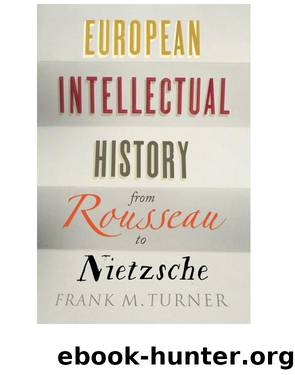European Intellectual History From Rousseau to Nietzsche by Turner Frank M

Author:Turner, Frank M.
Language: eng
Format: epub
ISBN: 9780300207293
Publisher: Yale University Press
Poetry is indeed something divine. It is at once the centre and circumference of knowledge; it is that which comprehends all science, and that to which all science must be referred …18
Poetry is the record of the best and happiest moments of the happiest and best minds … It is as it were the interpenetration of a diviner nature through our own; … Poetry redeems from decay the visitations of the divinity in man.19
Throughout the nineteenth century, artists would portray themselves and be portrayed as in some manner similarly connected to the divine. Artists came to see themselves as having nothing less than a religious vocation. Painters came to portray God in landscape. Poets came to be read as spiritual guides. Musicians attempted to create new religious mythologies. Museums and opera houses became places for religious experiences, and the reading of poetry by individual readers became the opportunity for personal religious or spiritual epiphanies.
Coleridge used the distinction between Classic and Romantic in lectures of 1811, but the term ‘romantic’ had very little usage in England until later in the century. The most famous English Romantic poets did not see themselves as Romantics in the continental sense. The person who was responsible for spreading this idea of ‘Romantic’ across Europe was Madame de Staël in her two-volume work De l’Allemagne, first published in 1813. It was really only after the publication of this work and other works critical of it that the term ‘Romantic’ spread throughout European literary circles. Stendhal may have been the first French writer to adapt the term. In a letter of 1818 he wrote, ‘I am a furious romantic, that is to say, I am for Shakespeare over Racine and for Lord Byron over Boileau.’
There has long been debate among scholars whether there really was such a thing as Romanticism, or more correctly whether there was a single group of phenomena in the literary and artistic worlds which had sufficient similarity to be grouped under a single term. It does seem possible, however, as René Wellek long ago argued, to suggest there was a certain unifying element to the diverse cultural manifestations often termed ‘Romantic’.
He pointed to three features:
1.‘imagination for the view of poetry’;
2.‘nature for the view of the world’;
3.‘symbol and myth for poetic style’.20
Download
This site does not store any files on its server. We only index and link to content provided by other sites. Please contact the content providers to delete copyright contents if any and email us, we'll remove relevant links or contents immediately.
| Africa | Americas |
| Arctic & Antarctica | Asia |
| Australia & Oceania | Europe |
| Middle East | Russia |
| United States | World |
| Ancient Civilizations | Military |
| Historical Study & Educational Resources |
Cecilia; Or, Memoirs of an Heiress — Volume 1 by Fanny Burney(32385)
Cecilia; Or, Memoirs of an Heiress — Volume 3 by Fanny Burney(31760)
Cecilia; Or, Memoirs of an Heiress — Volume 2 by Fanny Burney(31728)
The Secret History by Donna Tartt(18773)
Sapiens: A Brief History of Humankind by Yuval Noah Harari(14172)
Leonardo da Vinci by Walter Isaacson(13114)
The Radium Girls by Kate Moore(11877)
Sapiens by Yuval Noah Harari(5270)
How Democracies Die by Steven Levitsky & Daniel Ziblatt(5101)
The Wind in My Hair by Masih Alinejad(5014)
Homo Deus: A Brief History of Tomorrow by Yuval Noah Harari(4782)
Endurance: Shackleton's Incredible Voyage by Alfred Lansing(4635)
The Silk Roads by Peter Frankopan(4412)
Man's Search for Meaning by Viktor Frankl(4364)
Millionaire: The Philanderer, Gambler, and Duelist Who Invented Modern Finance by Janet Gleeson(4309)
The Rape of Nanking by Iris Chang(4108)
Joan of Arc by Mary Gordon(3987)
The Motorcycle Diaries by Ernesto Che Guevara(3941)
Hitler in Los Angeles by Steven J. Ross(3872)
